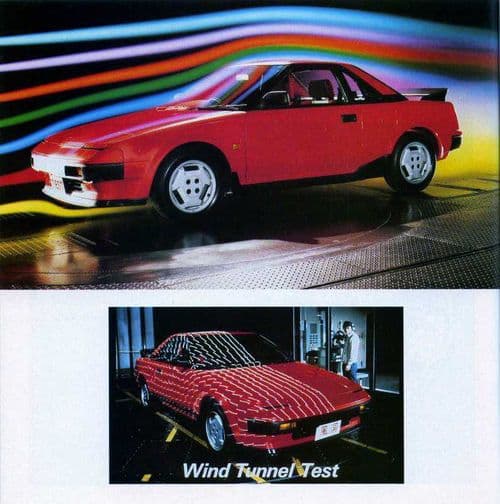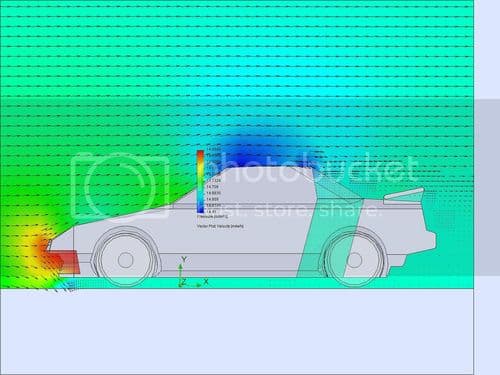Aerodynamics
1985-1989 coefficient of drag (C/D) 0.35, and 0.36 without the spoiler. Also refer to The Plumley Spoiler mod, where the stock spoiler is moved back around 4.5" for more effective down-force generation.

MR2OC member superpilun did a simple computational fluid dynamics (CFD) analysis on the Mk I MR2 based on an initial model created by MR2OC member bentheswift, using Solidworks FloWorks CFD software: http://mr2oc.com/showthread.php?t=250308
The analysis should be considered very basic and un-specific as the model was not particularly accurate or complete, and the CFD analysis itself was basic. However some basic conclusions can be drawn, if taken with a grain of salt:
The front bumper and grill are the points of highest pressure on the car, followed by the leading edge of the windshielf
The roof is the point of least pressure (or greatest low pressure region) on the car
Air in the engine bay travels from bottom to top at very low speed (in the range of 1-3% of vehicle speed)
For a stock car, the stock spoiler has virtually no effect on the airflow about the car
A fan in the engine bay pulling air downwards may encourage a greater pressure on the top of the spoiler, by pulling the region of turbulent flow over the engine bay down and re-attaching the flow to the body somewhat. However if a fan is blowing up and out of the bay, it increases the turbulence in that area and decreases the effect of any spoiler. This should be compared, on supercharged AW11s, to the fact that the intercooler is located at the engine bay exit duct – an upward-pulling fan may pull more, but hotter, air through the intercooler core.
These results may or may not apply to any degree to the Mk II MR2 body. The Mk I MR2 suffers from a tall cabin with a fairly short (longitudinally) roof, which causes a transition to turbulent flow at the leading edge of the roof. The Mk II cabin is lower and longer and the surfaces in general are smoother. In addition to the low pressure region directly above the car (synonymous with lift), this also causes separation at the trailing edge leading to turbulent flow over the spoiler, which causes it to be basically useless. However some Toyota literature noted that the shape of the spoiler was chosen (over a very different spoiler shown on the concept cars that led to the AW11) as a result of increased stability in crosswinds, which may justify it from a functional point of view.
Total aerodynamic forces at 100mph vehicle speed (Accuracy should not be trusted within more than +/- 10% or so):
Drag: 161 pounds
Lift: 101 lbs
Drag coefficient: .33
Lift coefficient: .06
Remember that CFD is an extremely complicated tool and that the results can’t be any more accurate than the inputs. Given that the model and the analysis were far from perfect, the results should not be taken as conclusive. The Mk I MR2 was chosen for this analysis because its boxy features are many times easier to model than a rounder, curvier body such as the Mk II MR2.


